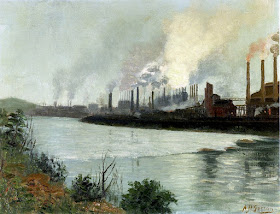“War is a racket. It always has
been. It is possibly the oldest, easily the most profitable, surely the most
vicious. It is the only one international in scope. It is the only one in which
the profits are reckoned in dollars and the losses in lives.”
—Smedley
D. Butler, War is a Racket (1935)*
The costs of the Great War were staggering. An estimated 41
million people were wounded or lost their lives, and from 1914 – 1918, the
Allied and Central Powers poured over 185 billion dollars into waging war. Adjusted for inflation, the amount today would
exceed 4.3 trillion dollars.**
Before the United States became involved in the global
conflict, many Americans wanted nothing to do with the war and hoped to remain
neutral. Others, however, seized war-time
opportunities to aggressively pursue profits.
In 1916, at a Washington, D.C. mass meeting of protest against the
war, Grace Isabel Colbron gave a public
reading of her poem “The Ballad of Bethlehem Steel.”***
The Ballad of Bethlehem Steel or “The Need For Preparedness”
A
Tale of the Ticker
A fort is taken, the papers say,
Five thousand dead in the murderous deal.
A victory? No, just another grim day.
But—up to
five hundred goes Bethlehem Steel.
 |
| The Masses, July 1916 Cartoon depicting Uncle Sam as war profiteer |
A sigh, a prayer from a torn heart rent—
A murmur of Peace on the death-laden air—
But—Bethlehem
Steel drops thirty per cent.
“We’ll fight to the death” the diplomats cry.
“We’ll fight to the death,” sigh the weary men.
As the battle roars to the shuddering sky—
And Bethlehem
Steel has a rise of ten.
What matters the loss of a million men?
What matters the waste of blossoming lands?
The children’s cry or the women’s pain?
If—Bethlehem
Steel at six hundred stands?
And so we must
join in the slaughter-mill,
We must arm
ourselves for a senseless hate,
We must waste our
youths in the murder drill—
That Bethlehem Steel may hold
its state.†
—Grace
Isabel Colbron
 |
| 1917 poster |
The upbeat rhythm and rhymes of the poem mimic the callously
optimistic mood of those who profited from the war. Celebrating those profits in May of 1916,
Charles Schwab, president of Bethlehem Steel, addressed the executives of the American
Iron and Steel Institute: “Boys, we are in a period of great prosperity. I
wonder if any of us ever expected, anticipated or dreamed that we should ever
see any such state of affairs as we see today….Boys, may this prosperity
continue.”††
Just how prosperous was Bethlehem Steel? In the months
before war was declared in Europe, the company struggled, operating at only 60%
capacity and reducing workers’ hours. But after securing military contracts
from Russia, Britain and France, Bethlehem Steel emerged as the leading
supplier of Allied ships, munitions, and ordnance. By end of 1917, “orders on
hand at Bethlehem Steel were twenty times as great as at the end of 1913,” and
stock prices had risen from $30 to $600 a share.°
Charges of war profiteering were not unique to America. Companies
in nearly every industrialized country sought to benefit from the war: Krupps (Germany)
Renault (France), and Vickers (Britain) are some of the better-known examples. The
war-time ideal of sacrifice was challenged when not everyone seemed to accept
an equal share of the sacrifice.
In 1935, fearing the prospect of yet another world war, Smedley
Butler spoke out against the capitalist motives that might support such a
war. A retired Major General with the
U.S. Marines, Butler condemned war profiteers in his book War is a Racket:
“At least 21,000 new millionaires
and billionaires were made in the United States during the World War. That many
admitted their huge blood gains in their income tax returns. How many other war
millionaires falsified their tax returns no one knows.
How many of these war millionaires
shouldered a rifle? How many of them dug a trench? How many of them knew what
it meant to go hungry in a rat-infested dug-out? How many of them spent
sleepless, frightened nights, ducking shells and shrapnel and machine gun
bullets? How many of them parried the bayonet thrust of an enemy? How many of
them were wounded or killed in battle?”
Butler concluded, “Beautiful ideals were painted for our
boys who were sent out to die. This was the ‘war to end wars.’ This was the ‘war
to make the world safe for democracy.’ No one told them that dollars and cents
were the real reason. No one mentioned to them, as they marched away, that
their going and their dying would mean huge war profits.”°°
Bethlehem Steel filed for bankruptcy in 2001.
-------------------------------------------------------------------------------------------------------
* Smedley D. Butler, War
is a Racket, Round Table Press, 1935, p. 1.
**“World War I casualties,”
Wikipedia and “Financial Cost of the
First World War,” Spartacus Educational.
***“To Read Original
Poem: Miss Colbron Writes Ballad for Meeting Against Preparedness.” Washington Evening Star, 29 Jan. 1916,
p. 10. Colbron was a translator, author,
and activist in both the pacifist and suffragist movements. A tribute written after
her death in 1943 described her as “a social idealist to the depths of her
soul, she was ready at any time to give of her best for any worthwhile project
for social reform” (W.L, “In Memoriam: Grace Isabel Colbron. The American Journal of Economics and
Sociology, Vol. 3, No. 1, Oct. 1943, p. 114).
†First
published in The Public: A Journal of
Democracy (10 Dec. 1915), the version included in this post appeared in Seamen’s Journal, Vol. 29, 22 Dec. 1916,
p. 11. Punctuation varies among
published editions of the poem; in the Presbyterian
Survey (Oct. 1916), the last word of the poem reads “rate”; other versions
read “state.”
††Kenneth Warren, Bethlehem
Steel: Builder and Arsenal of America, University of Pittsburgh, 2008, p.
105.
°Warren, Bethlehem
Steel, pp. 103-106.
°°Smedley D. Butler, War
is a Racket, pp. 2, 33.


















